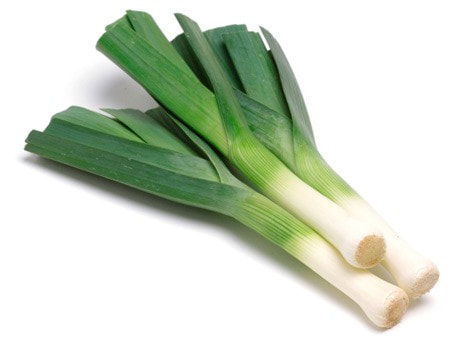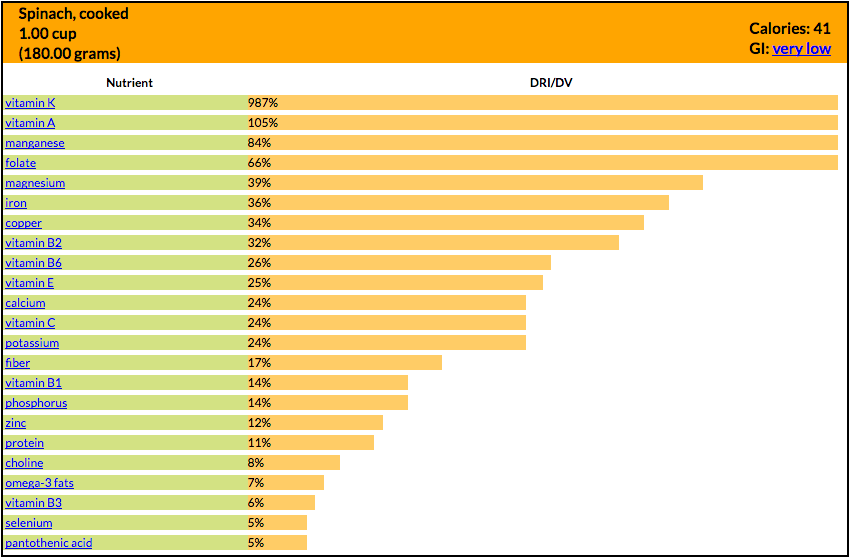|
Leeks are nutrient-rich. They contain the flavonoid kaempferol, which has repeatedly been shown to help protect our blood vessel linings from damage, including damage by overly reactive oxygen molecules. Leeks also contain an impressive amount of antioxidant polyphenols. Often overlooked, leeks have a high concentration of the B vitamin foltate, which is present in leeks in one of its bioactive forms (5-methyltetrahydrofolate, or 5MTHF). Similar to onions, garlic, shallots, and other allium vegetables, leeks also contain health-protective sulfur-containing phytonutrients. To receive these benefits, research suggests including at least one serving of an allium vegetable in your meal plan everyday. Although leeks are available throughout the year, they are in season from the fall through the early part of spring when their concentration of nutrients and flavor are highest, and their cost is usually the lowest. Leeks are considered to have a small amount of oxalates, which when accumulated may place the kidneys, of certain individuals, at risk of calcium oxalate kidney stone formation due to supersaturation of urine with calcium oxalate salts. Nutrient and Health Benefits Health-Promoting Benefits
Selecting Leeks Search for leeks that are firm and straight with dark green leaves and long white necks. They should be between 1/2 and 1 inch in diameter. As with all vegetables, it is recommended to select organically grown leeks when possible. Storing Leeks Preventing leeks from becoming limp and yellow will help protect nutrients and preserve flavor. Leeks will remain fresh for 1-2 weeks when properly stored. Preparing Leeks Properly clean and cut leeks to help ensure they will have the best flavor. After they are cut in half lengthwise, fan out the leeks and rinse again. Do not wash leeks before refrigeration because exposure to water will encourage leeks to spoil. Cooking Leeks Similar to onions, leeks are one of the most important seasonings, adding both aroma and nutrition to your meal. It is recommended to cook them just long enough to soften their fibers for better digestion and overall greater enjoyment. Researchers have well established that improper cooking, too much heat and long cooking times, can easily damage many nutrients present in leeks. For optimal results, the most nutritious way to cook leeks is to sauté them for only 7 minutes. References Mateljan, G. (2017). Leeks. [online] Whfoods.com. Available at: http://www.whfoods.com/genpage.php?tname=foodspice&dbid=26 [Accessed 4 Nov. 2017].
Mercola, J. (2017). What Are Leeks Good For? - Mercola.com. [online] Mercola.com. Available at: http://foodfacts.mercola.com/leeks.html [Accessed 4 Nov. 2017].
0 Comments
Calorie for calorie, leafy green vegetables like spinach, provide more nutrients than many other groups. Spinach is nearly at the top of the list for one of the most nutrient-rich foods. Spinach is an excellent source of iron, compared to meats, is very low in calories and virtually fat free. It is an excellent source of phytonutrients, such as beta-carotene, lutein, and zeaxanthin, which provide antioxidant protection. Spinach also contains over a dozen different flavonoid phytonutrients that function as anti-inflammatory compounds. One concern of spinach is that it is a concentrated source of oxalates, which when accumulated may place the kidneys, of certain individuals, at risk of calcium oxalate kidney stone formation due to supersaturation of urine with calcium oxalate salts. Nutrient and Health Benefits Health-Promoting Benefits
Selecting Spinach Choose spinach that has vibrant deep green leaves and stems with no signs of yellowing. The leaves should look fresh and tender, and not be wilted or bruised. Avoid those that have a slimy coating as this is an indication of decay. Spinach, being on the dirty dozen, retains a significant amount of pesticide residue. Therefore, as with all vegetables, it is recommended to select certified organically grown spinach when possible. Storing Spinach Do not wash spinach before storing as the exposure to water encourages spoilage. Place spinach in a plastic storage bag and wrap the bag tightly around the spinach, squeezing out as much of the air as possible. Place in refrigerator where it will keep fresh for up to 5 days. Avoid storing cooked spinach as it will not keep very well. Preparing Spinach Spinach should be washed very well since the leaves and stems tend to collect sand and soil. Before washing, trim off the roots and separate the leaves. Place the spinach in a large bowl of tepid water and swish the leaves around with your hands as this will allow any dirt to become dislodged. Remove the leaves from the water, empty the bowl, refill with clean water and repeat this process until no dirt remains in the water. Spinach sold in bags has been pre-washed and only needs to be rinsed. If you are going to use it in a salad, dry it using a salad spinner or by shaking it in a colander. Cooking Spinach Spinach is only one of three vegetables that is recommended to boil in order to free up acids and allow them to leach into the boiling water; this brings out a sweeter taste from the spinach. Discard the boiling water after cooking; do not drink it or use it for stock because of its acid content. Use a large pot (3 quart) with lots of water and bring to a rapid boil. Add spinach to the boiling water. Bring water back to boil and boil for 1 minute. Remove spinach from pot, press out liquid with a fork and place in a bowl. ReferencesMateljan, G. (2017). Spinach. [online] Whfoods.com. Available at: http://www.whfoods.com/genpage.php?tname=foodspice&dbid=43 [Accessed 17 Oct. 2017].
Mercola.com. (2017). What Is Spinach Good For? - Mercola.com. [online] Available at: http://foodfacts.mercola.com/spinach.html [Accessed 17 Oct. 2017]. Broccoli is synonymous with health. A large, growing body of evidence indicates that cruciferous vegetables, such as broccoli, have phenomenal health-promoting properties. To receive these health properties, it is recommended to consume broccoli on a regular basis. At a minimum, include 1-2 cups of cruciferous vegetables as part of your diet 2-3 times per week. Even better from a health standpoint, it is recommended to consume 2 cups of cruciferous vegetables 4-5 times per week. Broccoli is a member of the cruciferous (Brassica) family of vegetables that also includes cauliflower, kale, collard greens, cabbage, mustard greens, bok choy, turnip greens, Brussels sprouts, and many more. Nutrients and Health Benefits Health-Promoting Benefits
Selecting Broccoli For best taste, select the freshest broccoli and search for tightly closed floret clusters. Avoid broccoli with florets that are not compact or uniformly colored. They should not be yellow, bruised, or have yellow blossoms; these are indications that they are overly mature. Dark green Broccoli contains more chlorophyll, beta-carotene, and vitamin C, while purple-hued heads of broccoli contain higher concentrations of flavonoids. Search for firm stalks and stems and attached vibrant leaves. Do not purchase broccoli with stalks that are too wide, woody or hollow. As with all vegetables, it is recommended to select organically grown broccoli when possible. Storing Broccoli It is encouraged to consume broccoli as soon as possible after purchasing it for the most flavor and nutritional benefits. The longer it it stored, the more nutrients that are lost. It is not recommended to store broccoli for more than 7 days. Broccoli continues to respire (break down sugars and release carbon dioxide) even after being harvested. Reducing the storage temperature reduces the respiration rate. Preparing Broccoli Before cutting broccoli, rinse under cold running water. To minimize potential loss of nutrients, do not soak broccoli or the water-soluble nutrients will leach into the water. Never cut broccoli before washing. Upon cutting broccoli stems as close to the florets as possible, let them sit 5-10 minutes before cooking to bring out more flavor. The stems and leaves can either be enjoyed or saved for soup broth. Cooking Broccoli To maximize the nutritional benefits, broccoli should be cooked just long enough to soften its fibers. Researchers have well established that improper cooking, too much heat and long cooking times, can easily damage many nutrients present in broccoli. The most nutritious way to cook broccoli is a quick-steam at roughly 212 F for only 4 minutes. Use exact cooking times, and avoid using high heat to get water to a rapid boil and full steam. The stems will be required to cook 2 minutes longer due to fibrous structure. Vegetables, such as broccoli, can continue to cook if they are left in the pot after the heat is turned off. Therefore it is suggested to immediately remove broccoli from the pot to prevent overcooking. ReferencesMateljan, G. (2017). Broccoli. [online] Whfoods.com. Available at: http://www.whfoods.com/genpage.php?tname=foodspice&dbid=9 [Accessed 9 Oct. 2017].
Mercola.com. (2017). What Is Broccoli Good For? - Mercola.com. [online] Available at: http://foodfacts.mercola.com/broccoli.html [Accessed 9 Oct. 2017]. |
This portal contains research, news, information, observations, and ideas at the level of self in an effort to address lifestyle applications.
Archives
June 2024
Categories
All
|








 RSS Feed
RSS Feed

